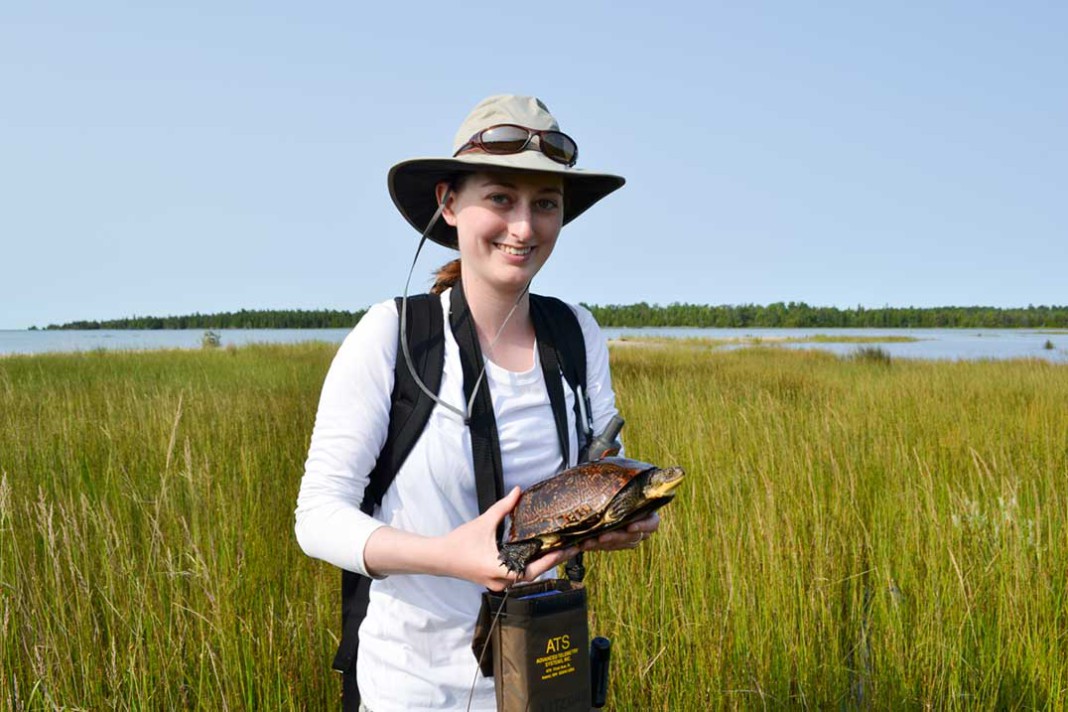MISERY BAY—It appears low water levels in Misery Bay are the most probable cause related to the mysterious deaths of over 71 turtles at Misery Bay Provincial Park on Western Manitoulin, says one of the main persons involved in the investigation of the (Blanding’s) turtles deaths.
“We think the deaths were tied to low water levels,” said Donnell Gasbarrini, a Laurentian University Masters of Science student who was part of the investigation-study. “We were thinking that during the mortality event in 2013, it was a low water year Misery Bay wetlands and the turtles were affected.”
Ms. Gasbarrini explained the Misery Bay wetlands, “are shallow to begin with and it (low water levels) restricts the area the turtles can use. So they would concentrate in pockets of areas. This in turn could make them more vulnerable to predators. We can’t be positive, but we think the deaths are tied to low water levels.”
“We have also researched droughts and turtle mortality in other areas,” said Ms. Gasbarrini. “There have been a lot of these type of cases in Canada and the US, so this goes in favour of our theory in this (Misery Bay) case.”
“We knew going into this study it would be hard to pinpoint the exact cause of the turtles’ mortality,” continued Ms. Gasbarrini, “but this is the most likely cause.”
A field study funded by the Ministry of Natural Resources and Forestry’s (MNRF) Species at Risk Stewardship Fund, using such devices as radio trackers, turtle decoys and field cameras to monitor potential predators in 2014 and 2015, was carried out by Ms. Gasbarrini and her field assistant Amber Koldzik.
It had been reported earlier that Ontario Parks ecologists Anna Sheppard and Ed Mooris had discovered dead turtles throughout April and May 2013 at Misery Bay Park while working on radio-tracking turtle movements, habitat and behaviour.
Ms. Gasbarrini said her study found the turtles were not hibernating near where the mortality hot spot had been. “We tracked the turtles at different times of the year to where they were going and if they had any wounds and if we could determine it was definitely due to predators. We wanted to do some sampling to see if disease could have led to the mortality of the turtles.”
“There was no scar tissue and we sampled the (deceased turtles) for rena virus, which recently were found to infest fox turtles,” said Ms. Gasbarrini. “So we took more samples but none of them were positive (for the rena virus).”
Ms. Gasbarrini continued, “with the time frame we had for the study we weren’t able to explore other options, but we did find otters and mink in the areas where the turtles ceased.” She explained that the location of the turtles nesting sites, with low water levels and low temperatures in the winter, as well as low oxygen levels, the turtles would not move very far from their hibernation area which could lead to easier access for predators.
“We knew going into this study that it was going to be hard to pinpoint the cause of their mortality,” said Ms. Gasbarrini. “But with the low water levels making it hard for them (turtles to get around), cold weather and predators around this is most likely the reason (for the turtle’s mortality.).”
Ms. Gasbarrini cautioned that without more opportunities for further study, or other options, it is impossible to determine a definitive cause for the mysterious deaths of the turtles in Misery Bay. “The two-year study provided only a small snapshot to gain information from.”
Ms. Gasbarrini explained previously there are three main reasons turtles die in the winter: freezing, not getting enough oxygen, or predation. The Blanding’s turtles’ Misery Bay habitat is shallow wetland. This could have created ice all the way down to where (underwater in the muddy bottom) the turtles were hibernating. This could lead to tissue freezing, or lead to the turtles not getting the oxygen they need through the water.




